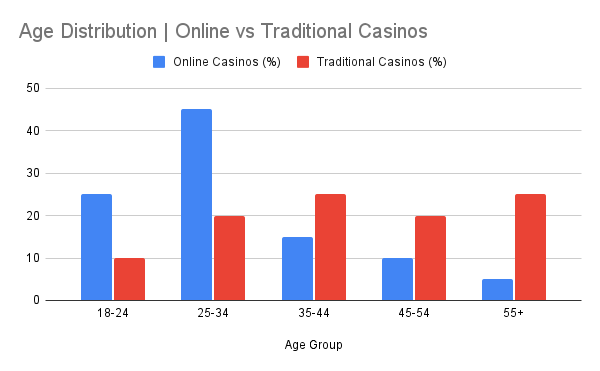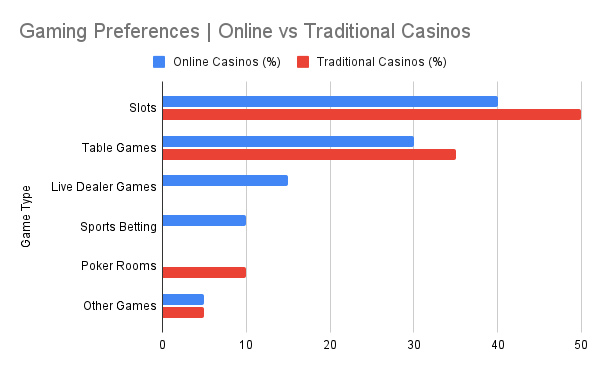Understanding Customer Demographics : Online vs Traditional Casino Gaming
Introduction
In the first blog of our series, we discussed the key distinctions between traditional and online casinos. If you haven’t read it yet, be sure to check it out here: Betting in the Digital Age: A Comparison of Online and Traditional Casino.
The transition from land-based casinos to online platforms has significantly altered the customer landscape. In the following blog, let’s take a closer look at how the demographics of visitors differ between these two gaming environments.
Age Demographics
Traditional casinos have historically attracted an older clientele, typically aged 45 and above. This group enjoys the face-to-face interaction, the live entertainment, and the overall ambiance of physical casinos, which offer experiences beyond gaming, such as dining and live shows. The thrill of being physically present at a table or slot machine plays a key role in their preference.
In contrast, online casinos appeal to a younger audience, generally in the 18 to 35 age range. This audience is drawn to the flexibility of online gaming, the wide variety of options, and the integration of modern technology, including mobile gaming and virtual reality. They also enjoy the privacy and anonymity that online platforms offer, making this environment their preference.

Age Distribution in Online vs Traditional Casinos
Geographic Reach
Traditional casinos are often located in major gambling destinations like Las Vegas, Atlantic City, or Macau, drawing a concentrated crowd of both locals and tourists. Tourists often visit these places for their magnificent experience in casinos. However, it limits the set of crowds who could not travel.
Online casinos eliminate these geographic barriers, making gaming accessible to players all around the world. This broad availability has created a diverse, global player base, with individuals from various regions participating in the same gaming environment.
Gender Distribution
In physical casinos, the gender split tends to be fairly balanced, with a slight male majority in some cases. The social atmosphere, combined with entertainment options that appeal to both men and women, keeps the gender mix relatively even.
Online casinos, meanwhile, have traditionally seen a higher proportion of male players, though this gap is gradually closing. More women are embracing the convenience and variety that online platforms offer, with the added anonymity making it a more comfortable space for those who might feel less at ease in a male-dominated physical setting.
Income and Spending Patterns
Visitors to traditional casinos typically have higher disposable incomes and are willing to spend more on the entire experience, which includes not just gambling, but also accommodation, dining, and entertainment. The luxury offerings of many casinos is appreciated by this wealthier demographic.
In contrast, online casinos attract a broader range of income levels. The lower costs associated with playing from home, and the flexibility in betting limits, make online gaming accessible to players with different financial backgrounds.
Gaming Preferences
Traditional casino visitors often prefer games that involve social interaction, such as poker, blackjack, and craps. This gives them a chance to engage with others at the table or interact with a live dealer. Slot machines also remain popular, especially among older visitors who enjoy their simplicity and nostalgia.
Online players, however, tend to seek games that offer quick access and faster results, like online slots, video poker, or digital versions of traditional table games. The growing popularity of live dealer games is helping to bridge the gap between the social aspect of physical casinos and the convenience of online gaming, appealing to a different set of players who value human interaction but also prefer to play from home.

Gaming Preference in Online vs Traditional Casinos
Rules and Regulations
Rules & regulations play a critical role in determining the accessibility and customer base for both traditional and online casinos. In regions where only physical casinos are legal, the customer base tends to lean toward older, wealthier individuals who enjoy the full entertainment package offered by these venues. The absence of online casinos in such places limits access for younger, tech-savvy users who may prefer the convenience of gaming from home.
On the contrary, regions that allow online gambling attract a wider, more diverse demographic, including younger generations, people from rural areas, and those with lower disposable incomes. In areas where online casinos are restricted, illegal or offshore alternatives may emerge, capturing a portion of the market that would otherwise prefer regulated, legal platforms. The impact of regulations is thus crucial in shaping the customer base for both forms of gaming.
Conclusion
Understanding the above demographics provides valuable insights for operators and marketers. These differences in age, gender, geography, income, and gaming preferences are key to crafting effective strategies for both platforms. As the gaming industry continues to evolve with technology, these trends are likely to shift, presenting new challenges and opportunities for both online and traditional casino operators.
Stay tuned for our upcoming Blog that will reflect upon how the odds of winning differ in these two gaming environments.
If you found this blog insightful, and are looking for opportunities for collaboration, head over to our iGaming space to find more about our expertise in this domain.

